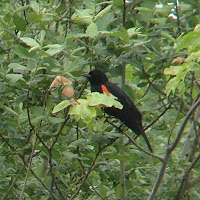 |
| A Goldfinch Pair |
Boston's Emerald Necklace is just a short T ride down the D-line. While most Boston area birders prefer the Back Bay Fens or Arnold Arboretum, the Riverway is right off the D-line and quite convenient to Newton birders. This narrow strip of park is centered upon the Muddy River and connects the Fens to Olmsted Park and Jamaica Pond, and fortunately offers enough habitat to offer shelter to tired migrants. I recently decided to stop off for some birding at Riverway on my way into Boston.
After getting off the T, the Riverway is accessed directly from the Longwood stop by heading over what I can only assume is a dike to ensure that the Muddy River and the T tracks never meet. As Riverway has paved or gravel trails on both sides of the River I decided to make a loop with Park Dr. on one side and Brookline Ave. on the other.
 |
| Black-and-white Warbler |
Right away my ears were asaulted by the songs of
Nothern Parulas,
Black-throated green and
Black-and-white warblers. The songs even led my eyes to these warblers for some great views (the Parula was quite high in the oaks). Ovenbirds called from the under growth, but never showed. While walking the banks of the Muddy River I noted that there were a couple of families in the river, both Mallard and Canada Geese. The goslings were starting to get lanky and less cute, but the mallard chicks looked more like corks bobbing in the water than the smooth paddling of their mom.
 |
| Northern Waterthrush |
Further down the trail, the river widens forming large pools with small islands. These islands were quite popular with warblers where I heared a Black-throated Blue's buzzy "zoo zoo zoo zree"
song! An American Redstart showed up flashing his brilliant red-orange patches on this black body and
calling "tse tse tse tse-o." Along the shores of the river I found a small thrush-like bird bobbing his tail, a
Northern Waterthrush, a warbler that looks and acts like thrushes by foraging on the banks of streams and ponds and sharing a spotted breast with thrushes. And speaking of thrushes, was even lucky enough to catch the song of a
Swainson's thrush. A beautiful flute-like raising song that he sang softly until a dog got a little too close for comfort and he became nervous. The spotted thrushes (including Veery, Wood, Hermit, Swainson's thrushes) are among North America's best songsters and as I have only heard the Wood Thrush's ethereal song before, I was disappointed not to be able to snatch a recording of the
Swainson's Thrush song. I was able to spot him well enough to make out the buff colored spectacles and face that is the hallmark of the Swainson's thrush.
Just before leaving I managed to find a Common Yellowthroat, a Spotted Sandpiper, and a female Red-wing Blackbird on her nest (she flew off just before I could take a picture).
 |
| The Longwood Ave. bridge over the Riverway was originally designed by Frederick Olmsted, the master planner for the Emerald Necklace. |











